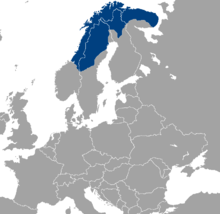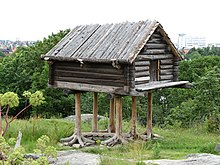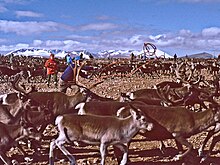The Sami are an indigenous ethnic group in the northern parts of Norway, Sweden, Finland and the Kola Peninsula in Russia.
Regions

- Norway: Troms and Finnmark
- Sweden: Norrbotten County, Västerbotten County and Jämtland County
- Finland: Finnish Lapland;
Enontekiö, Inari, Utsjoki and part of Sodankylä are recognised as the Sami native region - Russia: Kola Peninsula
Cities

- Karasjok (Kárášjohka), Finnmark, Norway – a village where the Sami Parliament of Norway is located
- Kiruna (Giron) – the seat of the Swedish Sami Parliament
- Inari (Anár, Aanaar, Aanar) – the "capital" of Finnish Samis
Other destinations
Sámi culture is not about city life. Although you will meet authentic Sámi in the towns, find museums, shops and exhibitions there and may have the chance to participate in Sámi festivals, an understanding of the Sámi necessarily includes a feeling for the wast areas outside cities. If you have time and are lucky you may join Sámi working with the reindeer on the fells. If you are a hiker you will appreciate the large wilderness areas. Otherwise you may get on an arranged tour, perhaps fishing in a lake far from the busy modern life.
Understand


Reindeer husbandry is an important livelihood among the Sámi and the culture surrounding the trade is important also for many with other professions. Even traditionally, though, not all Sámi have been involved in big scale reindeer husbandry, but lived from fishing, hunting and similar. Today many Sámi work in modern trades. Tourism in an important income in the Sámi area ("Sápmi").
As reindeer herders or hunters the Sámi traditionally followed the animals on their seasonal migrations, having a winter village, calving grounds and summer grounds, and mobile homes (goahtis and lávvus). The reindeer still have seasonal pastures (mostly treeless areas in summer), but the borders between countries, closed after failed negotiations in the 19th century, restricted the migration. With the introduction of motorized terrain vehicles (most importantly the snowmobile), reindeer herders have been able to reach their livestock from a permanent home, but many of the people you will meet were born before this revolution.
Many tourists in Sápmi want to experience the exotic Sámi culture. This has lead to non-Sámi dressing in quasi-Sámi clothes and performing "Sámi" rituals. You may enjoy these shows for what they are, but if you want to learn about Sámi culture, you should be wary of the difference. On the other hand real Sámi are, despite preserving a distinct culture and identity, mostly integrated in the modern lifestyle, and marriages across the cultural borders are quite common – you should not try too hard to find "authentic" Sámi.
Talk
There are several Sami languages, although Northern Sami is clearly the most widely spoken and understood also by many Sámi not having it as mother tongue. Because of earlier language policy not all Sami speak Sami at all. All speak the majority language of the country and they study English in school as other people. In Finland, Swedish is non-compulsory for those getting their education in Sami.
Most places in Sápmi have Sámi names. The names in the non-Sámi languages are often based on these, although the spelling may be quite different.
Get in
There are quite a few airports in the Sápmi area, with at least domestic flights.
The railways in Finland terminate at Kolari and Kemijärvi, with Rovaniemi the most important hub for continuing by coach.
Trains in Sweden go to Kiruna, and to Narvik in Norway.
The Norwegian trains terminate at Bodø.
For Norway, the Hurtigruten ferry service is an option.
Get around
The area is served by coaches, mostly at least with daily services. If you use your own car, be wary of the Norwegian terrain (there is quite a difference between the shortest route and the route by car) and driving conditions in winter. The distances are long, so biking requires some dedication. Taxis are a viable option for some destinations.
See
Museums
- 1 Siida (Inari Sámi Museum), Inarintie 46, Inari, FI-99870, ☏ +358 (0)400 898 212, siida@samimuseum.fi. Jun 1-Sep 19: 9:00-20:00; Sep 20-Mar 31: 10:00-17:00. The National Museum of the Finnish Sámi in Inari. Adults: €10.
- 2 Nutti Sámi Siida - Reindeer park and Sámi camp, Marknadsvägen 84, 981 91 Jukkasjärvi, ☏ +46 980 21329, info@nutti.se. Winter season: Dec 1-Apr 14, Daily 10:00–17:00; Summer season: June 17-Aug 11 Daily 10:00-16:00. Visitor center in Jukkasjärvi, Sweden, with reindeer and information about the Sámi people. Café and handcraft shop. Winter: Adult 150 SEK, student 100 SEK, children 75 SEK. Summer: Adult 120 SEK, student 100 SEK, children 60 SEK.
Do
Eat
- See also: Nordic cuisine
As agriculture is quite a hopeless enterprise with most crops at these latitudes, most dishes are based on reindeer, fish and game. Also some wild plants play or have traditionally played an important role, such as berries, especially cloudberry, and Norwegian angelica.
Drink
Stay safe
Sápmi, the Sámi region, is mostly very sparsely populated, with a harsh or even extreme climate. Do not get lost in the wilderness or get caught in a snowstorm without proper equipment.
Respect
Sami are often known in other languages as Lap, Lapons, Laplanders or similar, but many of them regard these as pejorative terms. Use Sami instead.
Go next
See also
- Vikings and the Old Norse for early Scandinavian history
